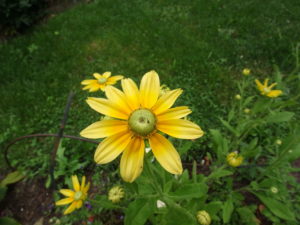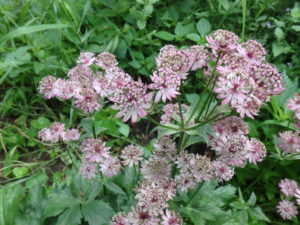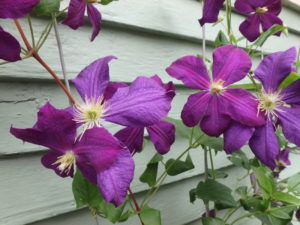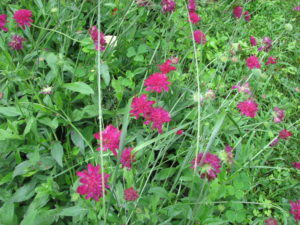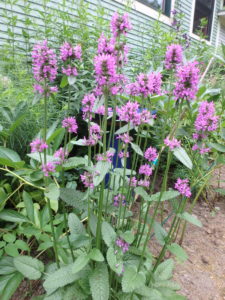July Beauties in the Flower Garden
Every day in the warm months I take time to wander through my garden, often with camera in hand. I am always greeted by flowers in bloom that make my heart sing. Here are some blooming for me now, including a few you might not grow – or not yet. I include the Latin names of plants, as common names vary from region to region.
Great masterwort (Astrantia major) comes with flowers ranging in color from white to lavender to reddish-purple. Its flowers are dome-shaped umbels (shaped like the stays of an umbrella). In ordinary garden soil it needs some shade, but in moist soil it will thrive in full sun. The leaves are tidy and stay in a nice clump a foot tall and 18 inches across; blossom stems can reach 2-feet tall, It is a good cut flower.
I have planted 4 species of milkweed to attract pollinators and to support our monarch butterflies. The monarchs (or their mimic, the Viceroy) were out recently and swooping around as singles or in pairs, perhaps in a mating dance. The swamp milkweed (Asclepias incarnata) is in full bloom now and the 5 plants I planted last year make a handsome 4-foot tall hedge topped with white flowers. I have it in full sun with moist soil, though it will thrive in ordinary garden soil.
On the front of the house I have a vine climbing up 10 feet or more on wires I installed for it. Currently it has 50 or 60 deep purple blossoms, each three to five inches across. It is a clematis, a species called Clematis jackmanii. Like all clematis, it does best with plenty of hot sun, but needs shade on its roots. I have tall perennials growing in front of it to accomplish that. Jackman’s clematis, as Latin-name-adverse gardeners call it, is one of the hardiest of all – easily surviving winter temperatures to 40 below.
You probably have grown that lovely purple-pink biennial foxglove that blooms in its second year, and then dies (Digitalis purpurea). I love it and spread the seeds after it blooms to get a few new babies the following spring. Mine are just now coming into bloom. But there are also a couple of perennial foxgloves, including a nice yellow one that is just finishing up its bloom period for me now. It is simply called yellow foxglove or Digitalis grandiflora. It does well in partial shade in rich, well-drained soil. It may re-bloom if you cut off the flower stalks after blooming. On the other hand, if you leave the stalks and seed pods, you may get more plants next spring. The other perennial foxglove I have grown is the small yellow foxglove, D. lutea, though it has been less long-lived than the larger one.
One of my favorite perennials is called knautia (Knautia macedonica). I love the wine-red, domed, one-inch flowers on thin stems that seem to float above its foliage, or the foliage of nearby plants. It drops seeds and volunteers show up, which is a good thing as it is not as long-lived plant. It does fine in full sun and ordinary soil. It is not common in garden centers, but if you see it, buy it!
Everyone has some black-eyed Susans (Rudbeckia spp.), either those you planted or as wildflowers along your fence line. They are tough and cheery. But I also have a named variety that is my favorite, ‘Prairie Sun’. Prairie Sun is not black-eyed, but green-eyed. It blooms prolifically from now until mid-October or even later. Although it is sold as a perennial, my experience is that it usually dies during the winter, though some plants do last 2 or 3 years. I grow it in full sun, a hot and dry location. It is hard to find as a plant, so you may want to start some from seed next spring.
Another great plant that I have only had in recent years is betony (Stachys monieri ‘Humelo’). Unlike the well-known lamb’s ears (Stachys byzantina), this does not flop, and the flowers are fabulous. The flowers are a pinkish-purple in a bottlebrush arrangement on nice stiff stems – perfect for cutting and using indoors in a vase. The leaves are a deep green and look good all summer in a nice tidy clump. Flower stalks stand up about 18 inches tall.
Annual poppies are blooming right now, and all of mine are self-seeded. I have planted them on either side of my brick front walkway in the past, but this year I just let them show up. I have the common orange one, the yellow California poppy, a double red one and one called ‘Ladybird’ that I bought as a six pack last year. Ladybird is a light purple with some large dark purple spots inside.
A few poppies seeded themselves between bricks in the walkway and bloomed! Save seeds this year if you have them, and sprinkle them on loose soil in the fall after cleanup, or in the spring. I have even sprinkled them on the snow in winter and gotten them to grow in spring.
And speaking of sowing annuals, I got a great mix of wildflowers from Renee’s Garden Seeds this year. I made a bed perhaps 5 feet by 2 feet and sprinkled the entire seed packet on the soil in the spring, just lightly covering the seeds and patting down. I now have a mass of color, mainly annual blue campanula and yellow calendula, with a few annual poppies. I like broadcasting annual flowers, letting them pop up in a random pattern, and have done it with zinnias and cosmos to great success. And if I save seeds, I can make my own mix.
Henry is a UNH Master Gardener and the author of 4 gardening books.



